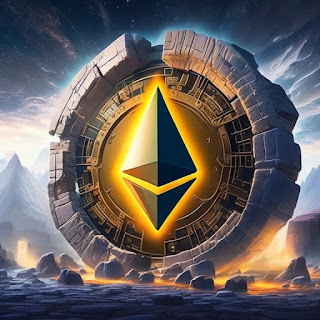In the ever-evolving landscape of blockchain technology, Ethereum has stood as a pioneer, revolutionizing the way we think about decentralization. While Ethereum's first iteration has made significant strides, the future of this remarkable platform lies in Ethereum 2.0—an ambitious upgrade set to unleash a new era of scalability, security, and sustainability. In this article, we explore the unique features and potential impact of Ethereum 2.0, revealing the transformative path it charts for the decentralized world.
1. Scaling Horizontally with Sharding:
Scalability has long been a challenge for blockchain networks, hindering their mass adoption. Ethereum 2.0 addresses this hurdle through a concept called sharding. By dividing the network into smaller units called shards, Ethereum 2.0 enables parallel processing of transactions, dramatically increasing the network's capacity. This horizontal scaling approach lays the foundation for a highly scalable Ethereum ecosystem capable of handling a vast number of transactions simultaneously.
2. The Beacon Chain: A Secure Backbone:
Ethereum 2.0 introduces the Beacon Chain, a fundamental component that acts as the core of the new network. The Beacon Chain operates on a proof-of-stake (PoS) consensus mechanism, which replaces the energy-intensive proof-of-work (PoW) model. PoS not only enhances the network's security but also significantly reduces its energy consumption. With the Beacon Chain securing the Ethereum 2.0 network, participants can engage in staking, validating transactions, and earning rewards for their contributions.
3. Validator Nodes: Empowering the Community:
Ethereum 2.0 emphasizes community participation through validator nodes. Individuals can become validators by staking their Ether (ETH) and actively participating in block validation. This inclusive approach empowers community members to directly contribute to network security and decentralization. Validators play a critical role in maintaining consensus, securing the network, and earning rewards in return. Ethereum 2.0 aims to create a truly decentralized ecosystem driven by a diverse community of validators.
4. A Greener and Sustainable Future:
One of the most compelling aspects of Ethereum 2.0 is its commitment to sustainability. By transitioning from PoW to PoS, Ethereum significantly reduces its energy consumption, making it more environmentally friendly. This shift aligns with the growing concern for sustainable blockchain solutions, ensuring that Ethereum remains at the forefront of eco-conscious innovation.
5. Beyond Finance: Expanding Possibilities:
While Ethereum has already made significant strides in decentralized finance (DeFi), Ethereum 2.0 opens doors to an array of new possibilities. With its enhanced scalability, developers can build more complex and feature-rich decentralized applications (dApps) that go beyond the realms of finance. Industries such as supply chain management, healthcare, gaming, and social networking can leverage Ethereum 2.0 to create innovative and secure solutions, revolutionizing how we interact with technology.
6. Cross-Chain Interoperability: Bridging Blockchain Networks:
Ethereum 2.0 recognizes the importance of interoperability and aims to bridge the gap between different blockchain networks. Through cross-chain communication protocols, Ethereum 2.0 opens avenues for seamless interaction and collaboration with other blockchains. This interoperability unlocks new possibilities for asset transfers, decentralized exchanges, and the integration of various blockchain ecosystems. By fostering a connected network of blockchains, Ethereum 2.0 promotes collaboration, innovation, and the broader adoption of decentralized technologies.
7. Privacy and Security Enhancements:
In addition to scalability and interoperability, Ethereum 2.0 places a strong emphasis on privacy and security. The upgrade introduces improved cryptographic techniques and advanced privacy features, allowing users to protect their data and transactions within the network. These enhancements provide a higher level of security, ensuring that Ethereum 2.0 becomes a trusted platform for individuals, enterprises, and even governments to leverage the benefits of decentralization without compromising sensitive information.
8. Empowering Developers: Enhanced Tooling and Development Frameworks:
Ethereum 2.0 aims to empower developers by providing enhanced tooling and development frameworks. The upgrade focuses on improving developer experiences and reducing complexities associated with building decentralized applications. This commitment to developer-friendly infrastructure encourages innovation, lowers barriers to entry, and enables a broader community of developers to contribute to the Ethereum ecosystem. As a result, we can expect a surge of creative and impactful decentralized applications built on Ethereum 2.0.
9. A Global Community: Fostering Collaboration and Governance:
Ethereum's strength lies in its vibrant and passionate community. Ethereum 2.0 further emphasizes community participation by introducing mechanisms for decentralized governance. Through decentralized governance, stakeholders have the power to propose and vote on protocol upgrades, ensuring that decisions align with the collective vision of the Ethereum community. This inclusive approach fosters collaboration, diversity, and decentralized decision-making, driving the platform's evolution based on the needs and aspirations of its users.
Conclusion:
Ethereum 2.0 represents a monumental leap forward in the evolution of blockchain technology. With its focus on scalability, sustainability, interoperability, and enhanced security, Ethereum 2.0 is poised to revolutionize industries, expand possibilities, and shape a decentralized future that benefits individuals and communities worldwide. As the upgrade unfolds and the Ethereum ecosystem evolves, we can look forward to a world where decentralized applications seamlessly integrate, where blockchain networks collaborate, and where the power of decentralization transcends borders, fostering trust, empowerment, and innovation on a global scale. Ethereum 2.0 is not just an upgrade—it's a transformative force paving the way for a decentralized revolution.

